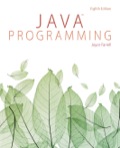
Explanation of Solution
a.
CarlysEventPriceWithMethods.java
//import the required packages
import java.util.Scanner;
//define a method CarlysEventPriceWithMethods
public class CarlysEventPriceWithMethods
{
//Scanner object
private static Scanner sc = new Scanner(System.in);
//define a method getEventNum()
public static String getEventNum()
{
//print the statement
System.out.println("Enter event number: ");
//scan the values
return sc.next();
}
//define the method getNoGuests
public static int getNoOfGuests()
{
//print the statement
System.out.println("Enter no of guests: ");
//return the value scanned
return sc.nextInt();
}
//define the method displayMotto()
public static void displayMotto(Event e)
{
//prin the values
System.out.println(String.format("%26s", " ").replace(" ", "*"));
System.out.printf("* %22s *", " ");
System.out.println("\n* Carly’s Catering *");
System.out.printf("* %22s *\n", " ");
System.out.println(String.format("%26s", " ").replace(" ", "*"));
System.out.println("Event No: " + e.getEventNum());
System.out.println("No. of guests:" + e.getNoOfGuest());
System.out.println("Price per guest: $" + Event.PRICE_PER_GUEST);
//call the method computePrice
computePrice(e);
}
//define the method computePrice
public static void computePrice(Event e)
{
//print the values
System.out.println("Price: $" + e.getPrice());
System.out.println("Large event: " + ((e.getNoOfGuest() > Event.CUT_OFF) ? "Yes" : "No"));
}
//define the main method
public static void main(String[] args)
{
//Close scanner
sc.close();
}
}
Explanation:
The above snippet of code is used to create a class “CarlysEventPriceWithMethods”. In the code,
- Import the required header files.
- Define a class “CarlysEventPriceWithMethods”
- Declare the object of “Scanner” class.
- Define the “getEventNum()” method.
- Prompt the user to enter the event number.
- Return the value of “name”.
- Define the “getNoGuests()” method.
- Return the scanned value.
- Define the “displayMotto()” method.
- Print the values.
- Call the method “computePrice()”.
- Define the “computePrice()” method.
- Print the values.
- Define the “main()” method.
- Close the scanner.
b.
Event.java
//define a class Event
public class Event
{
//declare the class members
public final static int PRICE_PER_GUEST = 35;
public final static int CUT_OFF = 50;
private String eventNum;
private int noOfGuest;
private int price;
//define a method setEventNum()
public void setEventNum(String eventNum)
{
//set the value of eventNum
this.eventNum = eventNum;
}
//define a method setNoOfGuest()
public void setNoOfGuest(int noOfGuest)
{
//set the values of noOfGuest
this.noOfGuest = noOfGuest;
//set the values of price
this...
Trending nowThis is a popular solution!

Chapter 3 Solutions
EBK JAVA PROGRAMMING
- What IETF protocol is NetFlow associated with? Group of answer choices IPX/SPX IPIX HTTPS SSHarrow_forwardHow can I perform Laplace Transformation when using integration based on this?arrow_forwardWrite an example of a personal reflection of your course. - What you liked about the course. - What you didn’t like about the course. - Suggestions for improvement. Course: Information and Decision Sciences (IDS) The Reflection Paper should be 1 or 2 pages in length.arrow_forward
- using r languagearrow_forwardI need help in explaining how I can demonstrate how the Laplace & Inverse transformations behaves in MATLAB transformation (ex: LIke in graph or something else)arrow_forwardYou have made the Web solution with Node.js. please let me know what problems and benefits I would experience while making the Web solution here, as compared to any other Web solution you have developed in the past. what problems and benefits/things to keep in mind as someone just learningarrow_forward
- PHP is the server-side scripting language. MySQL is used with PHP to store all the data. EXPLAIN in details how to install and run the PHP/MySQL on your computer. List the issues and challenges I may encounter while making this set-up? why I asked: I currently have issues logging into http://localhost/phpmyadmin/ and I tried using the command prompt in administrator to reset the password but I got the error LOCALHOST PORT not found.arrow_forwardHTML defines content, CSS defines layout, and JavaScript adds logic to the website on the client side. EXPLAIN IN DETAIL USING an example.arrow_forwardusing r languangearrow_forward
 EBK JAVA PROGRAMMINGComputer ScienceISBN:9781337671385Author:FARRELLPublisher:CENGAGE LEARNING - CONSIGNMENTProgramming Logic & Design ComprehensiveComputer ScienceISBN:9781337669405Author:FARRELLPublisher:Cengage
EBK JAVA PROGRAMMINGComputer ScienceISBN:9781337671385Author:FARRELLPublisher:CENGAGE LEARNING - CONSIGNMENTProgramming Logic & Design ComprehensiveComputer ScienceISBN:9781337669405Author:FARRELLPublisher:Cengage EBK JAVA PROGRAMMINGComputer ScienceISBN:9781305480537Author:FARRELLPublisher:CENGAGE LEARNING - CONSIGNMENT
EBK JAVA PROGRAMMINGComputer ScienceISBN:9781305480537Author:FARRELLPublisher:CENGAGE LEARNING - CONSIGNMENT Microsoft Visual C#Computer ScienceISBN:9781337102100Author:Joyce, Farrell.Publisher:Cengage Learning,
Microsoft Visual C#Computer ScienceISBN:9781337102100Author:Joyce, Farrell.Publisher:Cengage Learning, C++ Programming: From Problem Analysis to Program...Computer ScienceISBN:9781337102087Author:D. S. MalikPublisher:Cengage Learning
C++ Programming: From Problem Analysis to Program...Computer ScienceISBN:9781337102087Author:D. S. MalikPublisher:Cengage Learning Programming with Microsoft Visual Basic 2017Computer ScienceISBN:9781337102124Author:Diane ZakPublisher:Cengage Learning
Programming with Microsoft Visual Basic 2017Computer ScienceISBN:9781337102124Author:Diane ZakPublisher:Cengage Learning





